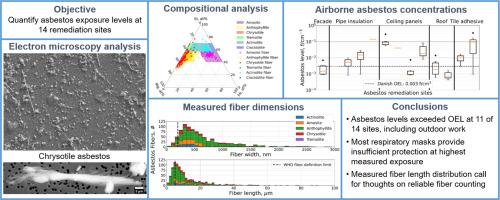Asbestos fiber levels from remediation work
IF 5.4
Q2 ENGINEERING, ENVIRONMENTAL
引用次数: 0
Abstract
Release of asbestos fibers during remediation and maintenance work remains a concern in many countries, as asbestos containing materials are often present in buildings predating their ban. Despite awareness of the adverse health effects from asbestos exposure, there is a lack of knowledge on concentrations resulting from typical asbestos remediation tasks, and on the minimum protection level needed. The aim of this study was to map asbestos exposure levels during removal of asbestos containing materials, in order to assess asbestos exposure levels and the adequacy of applied risk management measures, including choice of protective equipment. The investigated removal processes included asbestos containing facade panels, roof tiles, ceiling panels, tile adhesives, and insulation materials for pipes and boilers. All filter samples were analyzed by scanning electron microscopy coupled with energy dispersive X-ray spectroscopy. The highest asbestos concentration of 0.35 fibers/cm3 was found during removal of tiles with asbestos adhesives, though levels exceeding the current Danish occupational exposure limit of 0.003 f/cm3 were found in breathing zone samples at 11 of the 14 investigated sites. Even when considering 8 h time weighted average concentrations, levels were often found to exceed the occupational exposure limit, despite assuming a narrow exposure window, typically between 0.5 and 2 h due to high dust levels or short tasks. An additional objective was to provide guidance for decision-making in relation to two OEL options given in a recent EU Directive, where member states are also expected to transition from optical microscopy to electron microscopy for asbestos measurements.

石棉纤维水平从修复工作
在许多国家,在修复和维护工作期间释放石棉纤维仍然是一个令人关切的问题,因为在禁止使用石棉之前,建筑物中经常存在含石棉材料。尽管人们认识到接触石棉对健康的不利影响,但对典型的石棉补救工作产生的浓度以及所需的最低保护水平缺乏了解。本研究的目的是绘制移除含石棉材料期间的石棉暴露水平,以评估石棉暴露水平和应用的风险管理措施的充分性,包括防护设备的选择。调查的清除过程包括含有石棉的外墙板、屋顶瓦片、天花板板、瓦片粘合剂以及管道和锅炉的绝缘材料。采用扫描电子显微镜结合能量色散x射线能谱仪对滤光片样品进行分析。在拆除含石棉粘合剂的瓷砖时发现石棉浓度最高,为0.35纤维/cm3,尽管在14个调查地点中的11个呼吸区样本中发现的石棉浓度超过了丹麦目前的职业接触限值0.003 f/cm3。即使考虑到8小时时间加权平均浓度,水平也经常发现超过职业暴露限值,尽管假设一个狭窄的暴露窗口,通常在0.5到2小时之间,由于高粉尘水平或短任务。另一个目标是为最近欧盟指令中给出的两种OEL选择提供决策指导,其中成员国也有望从光学显微镜过渡到用于石棉测量的电子显微镜。
本文章由计算机程序翻译,如有差异,请以英文原文为准。
求助全文
约1分钟内获得全文
求助全文
来源期刊

Journal of hazardous materials advances
Environmental Engineering
CiteScore
4.80
自引率
0.00%
发文量
0
审稿时长
50 days
 求助内容:
求助内容: 应助结果提醒方式:
应助结果提醒方式:


